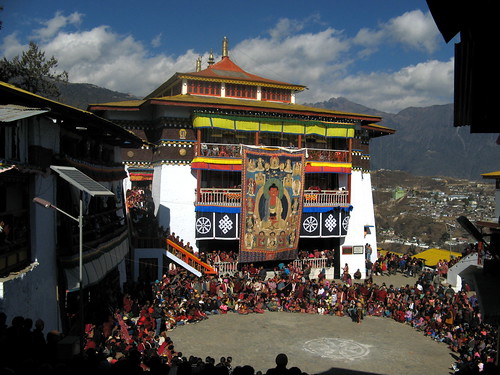
*Taj Mahal :
Taj Mahal is a famous monument located in Agra.
The Taj Mahal (also "the Taj") is considered the finest example of
Mughal architecture, a style that combines elements from
Persian, Turkish, Indian, and Islamic architectural styles.
The focus of the Taj Mahal is the white marble tomb, which stands on a square plinth consisting of a symmetrical building with an iwan, an arch-shaped doorway, topped by a large dome.
Was built by the Mughal emperor Shah Jahan (1628-1658), grandson of Akbar the great, in the memory of his queen
Arjumand Bano Begum, entitled ‘Mumtaz Mahal’.
The plinth and tomb took roughly 12 years to complete. The
remaining parts of the complex took an additional 10 years and
were completed in order of minarets, mosque and jawab and
gateway.
*The Golden Temple:
*TheGolden Temple is located in Amritsar, Punjab.
The door panes are decorated with artistic style. It opens on to
the bridge that leads to the main building of Sri Harmandir
Sahib. It is 202 feet in length and 21 feet in width.
Its architecture represents a unique harmony between the
Muslims and the Hindu architecture.
*Tawang Monastery:

*Located at an elevation of 10,000 feet in Tawang Town in Arunachal Pradesh.
The assembly hall has a 8.3 m high Golden Buddha statue.
Is 3 storeys high, occupies an area of 140 sq mt and houses 65 residential buildings.
The kakaling (entrance gate) is a large hut shaped structure made of stone.
*The Sun Temple:

*Situated at a distance from the famous religious and tourist centre of Puri (35 Km.) and the capital city of Bhubaneswar (65 Km).
The entire temple was designed in the shape of a colossal
chariot with seven horses and twenty four wheels, each about 10 feet in diameter, with a set of spokes and elaborate carvings.
It was built in red sandstone (Khandolite) and black granite.
The Sun Temple of Konark marks the highest point of achievement of Kalinga architecture depicting the grace, the joy and the rhythm of
life all in its wondrous variety.
It was built by King Raja Narasimhadeva-I of the Eastern Ganga Dynasty in the thirteenth century.
It is a temple to Surya, the sun God.
The Sun temple has been declared a world heritage site by UNESCO.
*Khajuraho:

*Khajuraho is a village in Madhya Pradesh, located in Chhatarpur District, about 620 kilometers southeast of Delhi.
The Khajuraho temples adhere to a northern Indian shikhara
temple style and often to a Panchayatana plan or layout.
Kandariya Mahadeva, comprises eighty-four shikharas, the
main being 116 feet from the ground level.
The Khajuraho temples were built over a span of a hundred
years, from 950A.D. to 1050A.D. They were rediscovered
during the late 19th century.
*Jaisalmer Fort:
The fort stands admist the golden stretches of the great Thar Desert, on Trikuta Hill and had been the scene of many battles.
It is also known as the "Golden Fort".
It is built of sandstone and is one of the largest forts in Rajasthan.
It was built in 1156 AD by the Bhati Rajput ruler Rawal Jaisal, from where it derives it name.
At one point of time the entire population of Jaisalmer used to live within the fort; but with the increase in the population, people was forced to move out and find shelter under the foot of the Trikuta Hill..
*Nalanda:

Located 55 miles from Patna in Bihar.
Nalanda was the largest residential centre of learning in the world with a 9 storied library.
The monasteries are built in old Kushan architectural style, in a row of cells around a courtyard.
It was the Buddhist center of learning from 427 to 1197 CE partly under the Pala Empire.
*Dholavira:

*Located in Kutch district
All its buildings are almost exclusively built out of brick.
The ancient site at Dholavira, is flanked by two storm water channels; the Mansar in the north, and the Manhar in the south.
Reservoirs are cut through stones vertically. They are about 7 meter deep and 79 meter long.
*Meenakshi Temple:

Located in the second largest city of Tamil Nadu i.e Madurai.
The temple complex is within a high-walled enclosure, at the core of which are the two sanctums for Meenakshi and Sundareshwara, surrounded by a number of smaller shrines and grand pillared halls.
The original temple was built by Kulasekara Pandya, but the credit for making the temple as splendid as it is today goes to the Nayaks.
The Nayaks ruled Madurai from the 16th to the 18th century and left a majestic imprint of their rule in the Meenakshi - Sundareswarar Temple.
The enormous temple complex is dedicated to Shiva, known as
Sundareshvara and his consort Parvatior Meenakshi.
According to legend Madurai is the actual site where the wedding between Shiva and Meenakshi took place.
Their soaring towers rise from solid granite bases, and are covered with stucco figures of deities, mythical animals and monsters painted in vivid colours.




